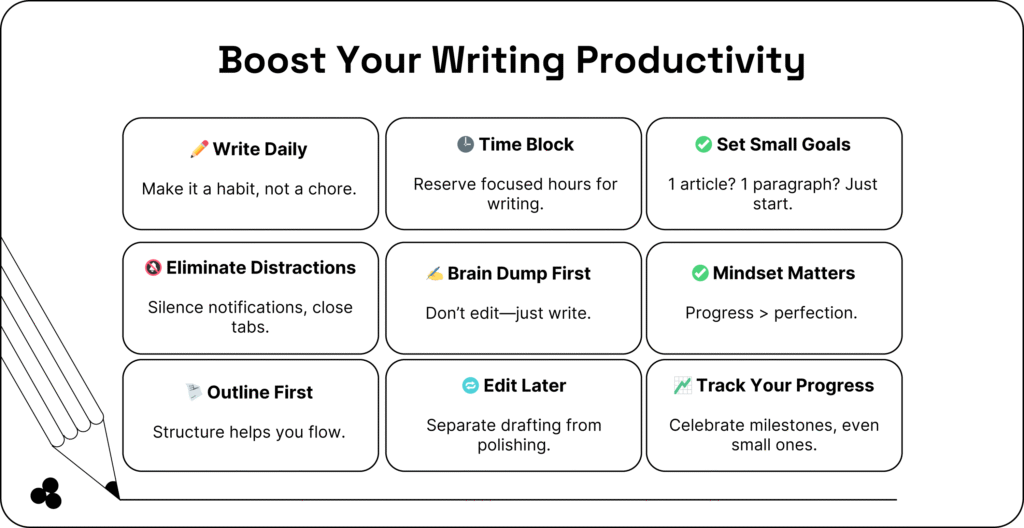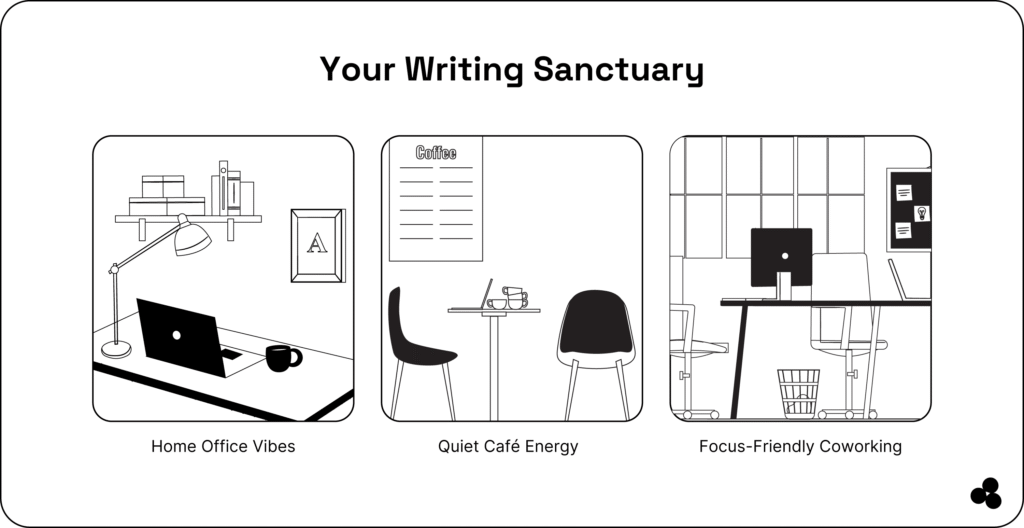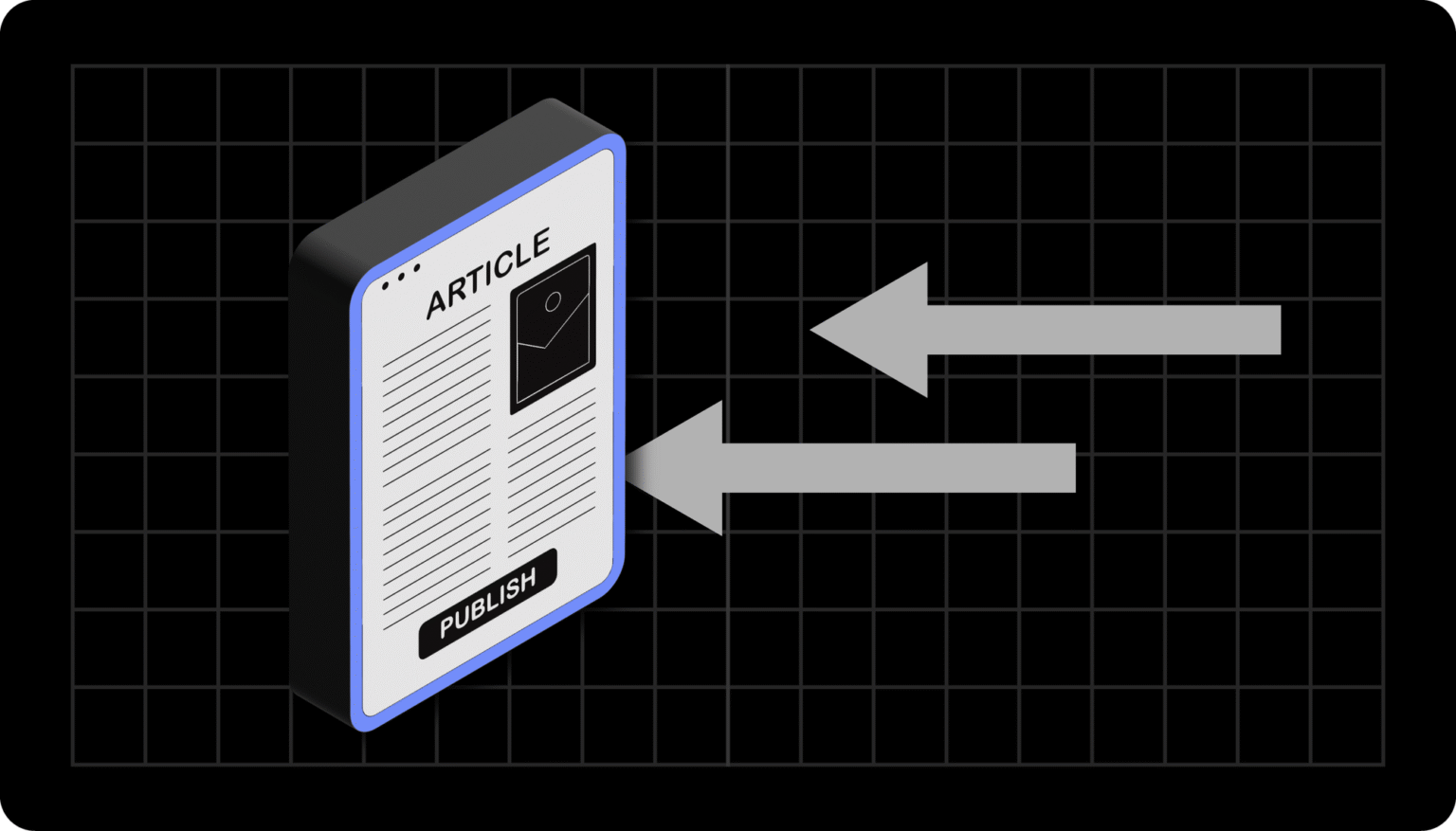Being a productive writer isn’t just about talent; it’s about developing effective habits, employing strategic approaches, and maintaining focus.
Whether you’re drafting blog posts, novels, or client content, staying consistent and efficient can feel impossible with distractions, deadlines, and creative blocks.
The good news? You can train yourself to write more effectively.
By adopting smart workflows, leveraging practical tools, and cultivating small yet powerful habits, you’ll write more efficiently, produce higher-quality work, and reduce stress along the way.
We will show you 16 actionable tips that any writer can implement immediately.
From setting goals to using AI tools, batching tasks, and rewarding yourself, these strategies are designed to help you become a productive writer—and maintain that productivity long-term.
💡 Tip: Productivity is a skill, not a trait. Start small, stay consistent, and watch your writing output grow.

1. Set Clear Writing Goals
Without clear goals, even the most motivated and productive writers can get lost in drafts. Define specific, measurable targets for every writing session.
- Use daily word count goals (e.g., 500–1000 words/day) or weekly content targets.
- Prioritize your tasks: what absolutely must be written today?
- Break larger projects into manageable sections, like chapters, blog sections, or research blocks.
📋 How can I track my writing progress? Track progress with apps like Penman or a simple spreadsheet to visualize daily output.
2. Create a Dedicated Writing Environment
Your environment directly affects your focus. A cluttered or noisy space can derail even the most disciplined, productive writer.
- Keep your workspace clean and distraction-free.
- Turn off notifications or use focus apps like Pomo Timer to enforce timed writing sessions.
- Consider ambient noise, music, or silence depending on your focus style.
💡 Tip: Even a small, quiet corner can drastically improve concentration. Your environment signals to your brain that it’s time to write.

3. Plan Your Writing Sessions
Planning your day prevents wasted time and mental fatigue. Schedule writing as a non-negotiable appointment.
- Use time-blocking to allocate uninterrupted writing periods.
- Apply the Pomodoro technique: 25 minutes of focused work + 5-minute breaks. Learn more here.
- Batch similar tasks together, like research, drafting, or editing.
📋 How long should a writing session be for maximum productivity? Most writers thrive in 25–50 minute focused blocks, with short breaks to refresh attention.
4. Prioritize Tasks
Not every writing task has an equal impact. Focus on what matters most first.
- Use the Eisenhower matrix to sort tasks by importance and urgency.
- Tackle high-value content (client work, major blog posts) before minor edits or formatting.
- Avoid spending too much time on low-priority drafts.
💡 Tip: Be realistic about daily goals—planning too much can be demotivating.
5. Minimize Distractions
Distractions are the silent productivity killers. Protect your focus actively to maintain the habits of a productive writer.
- Silence phones and notifications.
- Close unrelated browser tabs or apps.
- Use full-screen writing tools or distraction-free editors, such as Penman.
📋 What are some tools to stay focused while writing? Apps like Pomo Timer, Forest, or Focus@Will help sustain attention for longer writing sessions.
6. Use Writing Tools and Templates
Technology can save time and enhance productivity for any writer.
- AI-assisted writing: AI for Content Marketing
- Grammar and clarity: Grammar Checker
- Paraphrasing and rewording: Paraphrasing Tool
- Outline generation: Outline Generator AI
💡 Tip: Templates like A Beginner’s Guide to Structured Content reduce decision fatigue and save time.
7. Track Your Progress
Monitoring output keeps motivation high. Every productive writer knows that progress tracking reveals trends and improves focus.
- Maintain a daily word count log.
- Review your progress weekly to identify which strategies are working.
- Adjust goals based on performance and productivity patterns.
📋 How do I know if I’m writing efficiently? Consider both quantity and quality. If output meets goals without compromising clarity, you’re on the right track.
8. Take Breaks and Avoid Burnout
Sustained productivity requires rest. Productive writers take scheduled breaks to maintain energy and creativity.
- Stand, stretch, or take a walk between writing sessions.
- Hydrate and snack smartly to maintain energy.
- Step away from screens to refresh your mind.
💡 Tip: Using Pomodoro or similar timers ensures you don’t skip breaks—rest is essential for consistent productivity.
9. Review and Revise Strategically
Separate drafting from editing to maintain flow. This is a hallmark of any productive writer.
- Focus on drafting first; resist the urge to perfect every sentence.
- Schedule revision sessions dedicated to editing and improving clarity.
- Prioritize high-impact edits over minor tweaks.
📋 Should I edit as I write? Editing mid-writing interrupts the flow. Finish your draft first, then refine with tools like Penman.
10. Set Writing Rituals
Consistency is fueled by routine. Establish a pre-writing ritual to help you stay focused and productive as a writer.
- Start with deep breaths or meditation.
- Play the same playlist or background sound for every session.
- Open your writing apps in a fixed order.
💡 Tip: Rituals signal your brain it’s time to write, making it easier to enter flow states.
11. Limit Perfectionism
Overthinking slows progress. Productive writers know completion comes before perfection.
- Draft freely, then revise strategically.
- Accept that “done” is better than “perfect” for productivity.
📋 How do I stop over-editing? Set a timer for drafting and only edit during separate, dedicated sessions.
12. Use Voice-to-Text or Dictation
Speaking your ideas can accelerate content creation and help you write more like a productive writer.
- Dictate drafts with Google Docs Voice Typing or Microsoft Dictate.
- Edit afterward for structure and clarity.
💡 Tip: Many writers draft 2–3x faster using voice-to-text for initial ideas.
13. Collaborate and Get Feedback
Writing doesn’t have to be a solo endeavor. Feedback improves efficiency and quality for every productive writer.
- Share drafts early with peers or editors.
- Schedule quick check-ins to avoid long feedback delays.
💡 Tip: Fresh perspectives catch mistakes faster than prolonged self-editing.
14. Organize Research and Notes
Efficient research prevents distractions mid-draft, a key practice for a productive writer.
- Use Notion, Evernote, or Penman to structure notes.
- Tag ideas by topic, section, or priority.
- Collect research before writing to avoid context-switching.
💡 Tip: A well-organized research system saves hours over long projects.
15. Reward Yourself
Motivation improves when progress is celebrated. Every productive writer benefits from small rewards.
- Reward milestones, like completing a chapter or draft.
- Use small treats, walks, or coffee breaks as incentives.
💡 Tip: Even minor rewards reinforce consistent writing habits.
16. Batch Similar Tasks
Batching reduces cognitive load and maintains momentum for a productive writer.
- Draft multiple intros at once.
- Edit all headings together.
- Research all supporting stats before writing the main content.
💡 Tip: Batching minimizes task-switching and keeps your brain in “writing mode.”
Bonus Tip: Continuous Learning for Writers
Investing in skills keeps productivity high and work quality sharp.
- Explore creative writing courses like Short Courses Portal – Creative Writing
- Understand AI vs traditional writing: AI Writing vs Traditional Writing
- Master job-focused writing: Writing Job Descriptions
💡 Tip: The more tools and knowledge you master, the smoother your writing process becomes.

Start Writing Smarter Today
Being a productive writer isn’t about working harder—it’s about working smarter.
✅ Pick 3–5 tips from this guide to implement immediately.
✅ Track your progress and iterate on your workflow.
✅ Leverage tools, templates, and routines to save time and maintain quality.
Writing efficiently is a skill you build over time. Start small, stay consistent, and watch your output—and your confidence—soar.
💡 Final Thought: Productivity is not perfection. Focus, experiment, and celebrate every writing win.








